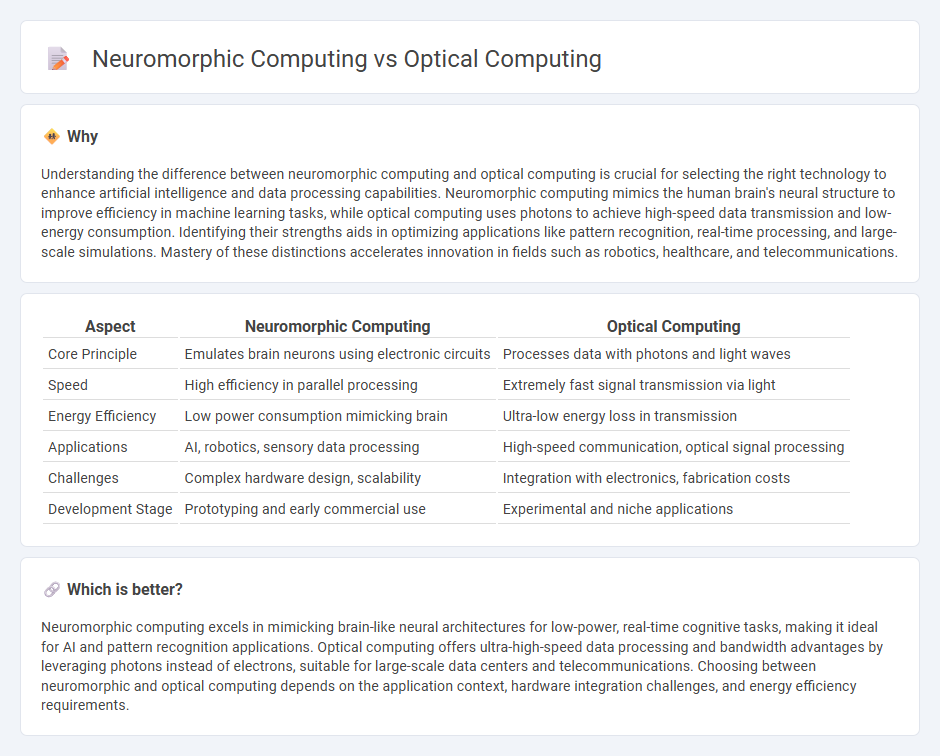
Neuromorphic computing mimics the neural structure of the human brain using artificial neurons and synapses to achieve energy-efficient processing and real-time learning capabilities. Optical computing leverages photons instead of electrons for data transmission and processing, enabling ultra-fast speeds and reduced heat generation. Explore the cutting-edge advancements and key differences between these revolutionary computing technologies.
Why it is important
Understanding the difference between neuromorphic computing and optical computing is crucial for selecting the right technology to enhance artificial intelligence and data processing capabilities. Neuromorphic computing mimics the human brain's neural structure to improve efficiency in machine learning tasks, while optical computing uses photons to achieve high-speed data transmission and low-energy consumption. Identifying their strengths aids in optimizing applications like pattern recognition, real-time processing, and large-scale simulations. Mastery of these distinctions accelerates innovation in fields such as robotics, healthcare, and telecommunications.
Comparison Table
| Aspect | Neuromorphic Computing | Optical Computing |
|---|---|---|
| Core Principle | Emulates brain neurons using electronic circuits | Processes data with photons and light waves |
| Speed | High efficiency in parallel processing | Extremely fast signal transmission via light |
| Energy Efficiency | Low power consumption mimicking brain | Ultra-low energy loss in transmission |
| Applications | AI, robotics, sensory data processing | High-speed communication, optical signal processing |
| Challenges | Complex hardware design, scalability | Integration with electronics, fabrication costs |
| Development Stage | Prototyping and early commercial use | Experimental and niche applications |
Which is better?
Neuromorphic computing excels in mimicking brain-like neural architectures for low-power, real-time cognitive tasks, making it ideal for AI and pattern recognition applications. Optical computing offers ultra-high-speed data processing and bandwidth advantages by leveraging photons instead of electrons, suitable for large-scale data centers and telecommunications. Choosing between neuromorphic and optical computing depends on the application context, hardware integration challenges, and energy efficiency requirements.
Connection
Neuromorphic computing and optical computing intersect through their shared goal of emulating brain-like processing speeds and energy efficiency by leveraging novel hardware architectures. Neuromorphic computing mimics neural structures using electronic circuits, while optical computing processes data with photons, enabling ultrafast signal transmission and parallelism. Integrating optical components into neuromorphic systems enhances data throughput and reduces latency, advancing artificial intelligence and machine learning applications.
Key Terms
Photonics
Optical computing leverages photonics to perform data processing with light, enabling ultra-fast signal transmission and low energy consumption, particularly in applications requiring high bandwidth and parallelism. Neuromorphic computing, inspired by the brain's neural architecture, uses photonic components to mimic synaptic connections and neuron-like behavior for efficient cognitive tasks and real-time learning. Explore how the synergy of photonics accelerates both optical and neuromorphic computing for transformative advancements in AI and data processing.
Spiking Neural Networks
Optical computing leverages photons for data transmission and processing, enabling ultra-fast and energy-efficient operations ideal for implementing Spiking Neural Networks (SNNs) that mimic biological neurons with precise temporal spikes. Neuromorphic computing emulates neural architectures using electronic circuits to replicate spiking behavior, focusing on low-power, real-time processing for SNNs in applications like pattern recognition and sensory data integration. Explore the latest advancements and comparative benefits of optical and neuromorphic approaches in optimizing Spiking Neural Networks.
Parallelism
Optical computing utilizes photonic components to achieve massive parallelism by processing multiple light signals simultaneously, enabling ultra-fast data transmission and high-bandwidth computations. Neuromorphic computing mimics the parallel architecture of the human brain through interconnected spiking neurons, offering energy-efficient processing and adaptability for complex pattern recognition tasks. Explore further to understand how parallelism drives innovation in these cutting-edge computational paradigms.
Source and External Links
Optical computing - Wikipedia - This page describes the concept of optical computing, which uses light for data processing and communication, offering higher bandwidth and potential integration into traditional computers.
All-Optical Computer Unveiled With 100 GHz Clock Speed - Researchers have developed an all-optical computer capable of performing tasks at speeds of up to 100 GHz, utilizing an optical cavity for memory and processing.
Optical Computing: The Power of Light - This article explains optical computing, which uses photons for calculations, offering advantages like high speed and low interference, but faces challenges in component development.
 dowidth.com
dowidth.com